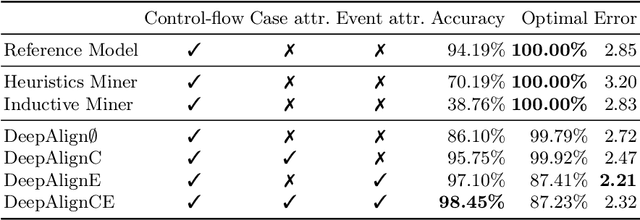Alexander Seeliger
DeepAlign: Alignment-based Process Anomaly Correction using Recurrent Neural Networks
Nov 29, 2019



Abstract:In this paper, we propose DeepAlign, a novel approach to multi-perspective process anomaly correction, based on recurrent neural networks and bidirectional beam search. At the core of the DeepAlign algorithm are two recurrent neural networks trained to predict the next event. One is reading sequences of process executions from left to right, while the other is reading the sequences from right to left. By combining the predictive capabilities of both neural networks, we show that it is possible to calculate sequence alignments, which are used to detect and correct anomalies. DeepAlign utilizes the case-level and event-level attributes to closely model the decisions within a process. We evaluate the performance of our approach on an elaborate data corpus of 30 realistic synthetic event logs and compare it to three state-of-the-art conformance checking methods. DeepAlign produces better corrections than the rest of the field reaching an overall accuracy of 98.45% across all datasets, whereas the best comparable state-of-the-art method reaches 70.19%.
BINet: Multi-perspective Business Process Anomaly Classification
Feb 08, 2019



Abstract:In this paper, we introduce BINet, a neural network architecture for real-time multi-perspective anomaly detection in business process event logs. BINet is designed to handle both the control flow and the data perspective of a business process. Additionally, we propose a set of heuristics for setting the threshold of an anomaly detection algorithm automatically. We demonstrate that BINet can be used to detect anomalies in event logs not only on a case level but also on event attribute level. Finally, we demonstrate that a simple set of rules can be used to utilize the output of BINet for anomaly classification. We compare BINet to eight other state-of-the-art anomaly detection algorithms and evaluate their performance on an elaborate data corpus of 29 synthetic and 15 real-life event logs. BINet outperforms all other methods both on the synthetic as well as on the real-life datasets.
Analyzing Business Process Anomalies Using Autoencoders
Mar 03, 2018



Abstract:Businesses are naturally interested in detecting anomalies in their internal processes, because these can be indicators for fraud and inefficiencies. Within the domain of business intelligence, classic anomaly detection is not very frequently researched. In this paper, we propose a method, using autoencoders, for detecting and analyzing anomalies occurring in the execution of a business process. Our method does not rely on any prior knowledge about the process and can be trained on a noisy dataset already containing the anomalies. We demonstrate its effectiveness by evaluating it on 700 different datasets and testing its performance against three state-of-the-art anomaly detection methods. This paper is an extension of our previous work from 2016 [30]. Compared to the original publication we have further refined the approach in terms of performance and conducted an elaborate evaluation on more sophisticated datasets including real-life event logs from the Business Process Intelligence Challenges of 2012 and 2017. In our experiments our approach reached an F1 score of 0.87, whereas the best unaltered state-of-the-art approach reached an F1 score of 0.72. Furthermore, our approach can be used to analyze the detected anomalies in terms of which event within one execution of the process causes the anomaly.
 Add to Chrome
Add to Chrome Add to Firefox
Add to Firefox Add to Edge
Add to Edge